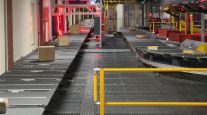Staff Reporter
Coronavirus Accelerates Logistics Sector Innovations

[Ensure you have all the info you need in these unprecedented times. Subscribe now.]
The DHL Logistics Trend Radar report looked at trends that could reshape logistics in the future, and are particularly focused on technology.
The report, its fifth edition, was issued Sept. 25, highlights sustainability and global volatility and notes that the logistics sector is entering a transformative decade.
The report also detailed the significant impact the coronavirus pandemic has had on these trends. Supply chains and logistics operations have been on the front line of the pandemic. They’ve kept essential supplies moving despite significant transport disruptions, movement restrictions and dramatic volatility. Those complications have instead accelerated the need to innovate.
Discover the 29 key #trends that will impact the #logistics #industry over the next years in our fifth edition of the DHL Logistics Trend Radar: https://t.co/RgamFgamuc pic.twitter.com/p58OA0TK7o — DHL Global Trade (@DHLGlobal) September 22, 2020
“COVID-19 has demonstrated just how critical supply chains are,” Gina Chung, vice president of innovation for the Americas at DHL, told Transport Topics. “We see some of these trends like automation, analytics and real-time visibility. They’re accelerating due to COVID and due to the pressures that have been put on global supply chains.”
Chung added the Trend Radar report is a way for people to look into the future of supply chains and understand how they can leverage some of these trends so that they can build more resilience and future-proof their operations.
“There hasn’t been one trend or factor that has caused so much change in such a short amount of time,” Chung said. “But COVID is definitely one of them. So a lot of discussions we have right now with customers is, ‘I really need to start investing in some of these technology trends that will help me get more visibility and more control of the supply chain,’ which has been an issue throughout the COVID-19 crisis.”
The logistics sector using robotics and automation proved to be useful given the pandemic spurred practices like social distancing. At the same time, fulfillment facilities were facing labor shortages when e-commerce was on the rise. The report highlighted trailer unloading as an example of how robotics has kept workers separated.
Similarly, logistics companies have also embraced contactless operations to mitigate the pandemic risks. This includes delivery options such as parcel lockers, autonomous delivery robots and in-app signature software. Logistics facilities have been adopting fixed presentation scanners so operators don’t have to touch items like handheld scanners.
The report also highlighted how companies have more readily turned toward 3D printing to meet the rapid rise in demand for personal protective equipment and ventilators. There has also been a greater shift toward using wearable technologies like smart glasses and augmented reality solutions that allow a remote expert to support on-site personnel.
“There are certain COVID-19 related innovations that might taper off,” Chung said. “What will not taper off is how much organizations, especially our customers, have recognized the value of future-proofing their supply chain through technology.”
Chung added rather that mindset of future-proofing supply chains will likely accelerate as companies move past the coronavirus pandemic. But she also noted that it’s too soon to tell how all that will exactly play out.
The coronavirus may have helped fuel these trends but that came after years of an already rapidly changing logistics sector. Logistics companies have long looked into these innovations along with other trends such as advanced analytics and Internet of Things solutions. There have also been trends driving these changes like globalization, volatility and disruptive technologies investments.
“On top of the continued globalization and volatility that we’re experiencing this year, two other things that come into play is the continued growth of e-commerce,” Chung said. “Then the fourth one would be sustainability. Sustainability will just be a key part of the future of the logistics industry. Every single logistics provider needs to be investing into sustainability today to be ready for the future.”
DHL is a multinational package delivery and supply chain management company with several divisions. DHL Supply Chain, a division of the company, ranks No. 3 on the Transport Topics Top 50 list of the largest logistics companies in North America.
Want more news? Listen to today's daily briefing:
Subscribe: Apple Podcasts | Spotify | Amazon Alexa | Google Assistant | More


